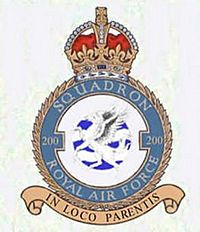No. 200 Squadron RAF facts for kids
Quick facts for kids No. 200 Squadron RAF |
|
|---|---|

No. 200 Squadron badge
|
|
| Active | July 1917 – 13 June 1919 May 1941 – April 1945 |
| Country | United Kingdom |
| Branch | Royal Air Force |
| Motto(s) | Latin: In loco parentis "We act as guardians" |
| Equipment | Lockheed Hudson Consolidated Liberator |
| Insignia | |
| Squadron Badge heraldry | In front of a fountain, a Pegasus. |
No. 200 Squadron was a special group of pilots and planes in the Royal Air Force (RAF). They flew missions during both the First World War and the Second World War. This squadron first started in 1917. During the First World War, their job was to train new pilots. They were closed down in 1919.
The squadron started again in 1941 for the Second World War. This time, they flew planes that watched over the ocean. They first flew from the United Kingdom. Then they moved to West Africa. In 1944, they moved to India. No. 200 Squadron was closed for good in April 1945. Its members became part of No. 8 Squadron RAF.
Contents
No. 200 Squadron in the First World War
No. 200 Depot Squadron Royal Flying Corps began on July 1, 1917. This happened in a place called East Retford. The squadron used Royal Aircraft Factory F.E.2 planes. Their main job was to train pilots for night flying. After the war ended, the squadron was closed. This happened on June 13, 1919.
No. 200 Squadron in the Second World War
The squadron started again on May 25, 1941. It was formed from a part of No. 206 Squadron RAF. This happened at RAF Bircham Newton in Norfolk, England. The first Lockheed Hudson planes arrived in early June. These planes were used for watching over the sea.
Missions in Africa
Later in June, the squadron moved to Gibraltar. Then they went to the Gambia in West Africa. From there, they flew missions to protect ships. These ships were traveling in groups called convoys. The squadron flew from a base called Jeswang. In 1943, they moved to Yundum. There, they got new planes. These were bigger, four-engine Consolidated Liberator VI bombers. Some parts of the squadron also flew from other airfields in West Africa.
Moving to India
In March 1944, the squadron moved again. They went to Madras in India. This was part of the South East Asia Command. They flew only a few missions from Madras. Then they moved to Bengal for special jobs. These jobs mainly involved flying supplies. They also dropped off special teams into Burma and Malaya. These teams were often guerrilla groups. In April 1945, the squadron was renumbered. It became No. 8 Squadron RAF. This meant No. 200 Squadron was officially closed.
Victoria Cross Hero: Lloyd Allan Trigg
In August 1943, a pilot named Flying Officer Lloyd Allan Trigg became a hero. He was given the Victoria Cross. This is the highest award for bravery in the British military. He earned it for sinking a German submarine called U-468.
Flying Officer Trigg was flying a Liberator V plane from Banjul. He attacked the submarine with special bombs called depth-charges. The submarine fired back heavily at his plane. Sadly, his plane crashed into the ocean. All the crew members were lost.
The only people who survived were seven German sailors from the submarine. They told everyone how brave the aircrew had been. This is very rare. It is one of the only times the Victoria Cross has been given because an enemy officer said someone deserved it. It is the only time it was awarded only based on what the enemy said.
Aircraft Used by No. 200 Squadron
- 1941–1942 Lockheed Hudson IV
- 1942–1943 Lockheed Hudson III and IIIA
- 1942–1943 Lockheed Hudson VI
- 1943–1944 Consolidated Liberator V
- 1944–1945 Consolidated Liberator VI
See also
- List of Royal Air Force aircraft squadrons

